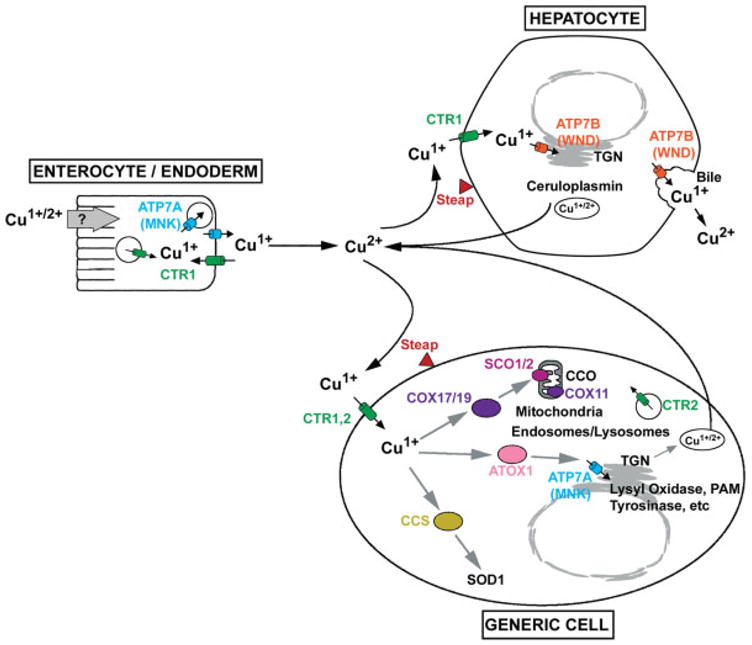FIG. 1.

Overview of copper homeostasis. Copper is oxidized (Cu2+) in the intestinal lumen and in the serum, but is reduced to Cu1+ before transport into cells. The Steap ferric/cupric reductases (Steaps 2, 3, and 4) are localized to endosomes/lysosomes and the plasma membrane and may be essential for the reduction of copper, as well as the reduction of iron (Ohgami et al., 2006). Copper is transported into ENTEROCYTE/ENDODERM cells by unknown mechanisms (endocytosis?). CTR1 is essential for the acquisition of dietary copper but its function in the enterocyte is unknown. In many other cell types (GENERIC CELL), copper is taken up by CTR1 localized to the plasma membrane and perhaps also by CTR2 (Slc31a2). Copper taken up by ENTEROCYTE/ENDODERM is exported into portal blood/conceptus, respectively, by ATP7A (Menkes disease protein, MNK) which is localized to vesicles trafficking toward the basolateral membrane and to the basolateral membrane. Copper exported to portal blood is taken up into the liver, the primary organ that regulates copper homeostasis. In the HEPATOCYTE, ATP7B (Wilson’s disease protein, WND) effluxes excess copper into the bile and puts copper into the trans-Golgi network (TGN) where it is loaded into ceruloplasmin, a ferroxidase that is the primary copper binding protein in serum. Inside the cell (GENERIC CELL), copper is distributed to cytoplasmic copper chaperones (COX17/19, ATOX1, CCS) which, in turn, deliver copper to mitochondrial inner membrane and ultimately cytochrome C oxidase (CCO) or to ATP7A in the TGN, and cytoplasmic SOD1, respectively. The assembly of copper into CCO is an active area of investigation. It is thought that copper in COX17/19 (and probably COX23/MTCP1) is first transferred to both COX11 and SCO1/2 and ultimately to CCO. ATP7A transports copper into the TGN and activates copper containing secretory and membrane-bound proteins [lysyl oxidase, tyrosinase, peptidylglycine α-amidating monooxygenase (PAM)]. It should be noted that the cellular localization and abundance of CTR1, ATP7A, and ATP7B are dynamically regulated by copper availability which is not reflected in this static cartoon.
